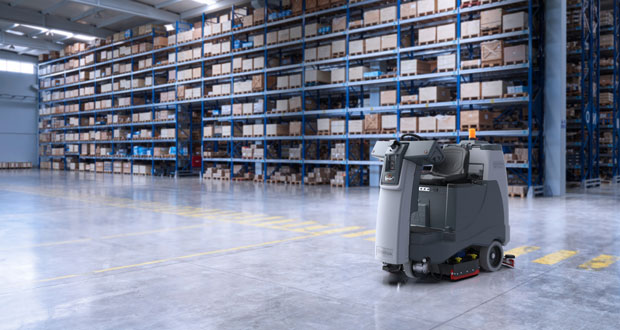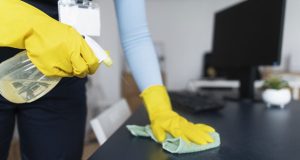As pandemic restrictions are slowly lifted, self-driving robots are not only delivering improved cleaning efficiency and performance, but are also serving as powerful visual affirmations of the importance of increased hygiene and cleanliness.
Once predominantly a fixture on the night shift, robotic floor scrubbers have increasingly been deployed during daytime hours to improve customer and visitor experiences alongside the benefits they bring for workers. They are set to play an expanding role during the remainder of the pandemic – and even after – helping to reassure both members of the public and employees that spaces are safe and clean.
The increase of autonomous cleaning robots in workplaces has been shown to reduce the degree of contact between co-workers, allowing social distancing to be observed more meaningfully. This enhances the safety of workplaces and encourages anxious employees back into work.
Easier deployment
Until recently, autonomous robots were most commonly found in warehouse and manufacturing settings, hidden from public view and operated by technical support staff.
With these devices increasingly making their way into commercial, public-facing environments such as retail and grocery stores, they have also been designed for operation by non-technical users.
Robots that are now being used in retail workplaces include highly intuitive user interfaces, graphical reporting, and simple deployment procedures, so that they can be easily implemented and do the heavy lifting required to ensure optimal hygiene in commercial spaces.
Simple-to-master controls will become increasingly important for commercial robots as they increasingly find their place as part of the workforce. Many newer automated machines, such as those powered by Brain Corp, have a unique “teach and repeat” methodology, which allows them to be easily programmed by shop floor staff.
Advanced vision-based AI systems enable the robots to safely navigate complex, real-world environments, creating a “safety zone” around the machines. Multi-layer sensor systems perceive the surrounding environment, detecting and avoiding people and obstacles. The machines can therefore work autonomously, clean efficiently alongside humans in complex and dynamic locations. Additionally, they can still be used manually for ad-hoc situations.
Unprecedented Trackability
In the past, ‘proof of work’ metrics were hard to come by when it came to commercial cleaning. Setting up a cleaning routine was one thing, but proving that workplaces were clean had traditionally been a major limitation.
With the advent of autonomous solutions, cleaning operations can be monitored with data provided on areas covered, number of routes run, percentage of autonomous usage hours versus manned, and other KPIs. Visual heat maps showing areas cleaned allow managers to verify which areas have been cleaned.
Such detailed data means that cleaning operations can be optimised and hygiene compliance goals can be assured. In the coming years, a greater number of industrial facilities will use robotic performance data to hone their operations and generate reliable “proof of work” metrics.
Via cloud-based AI software platforms, it will be possible to oversee entire robotic fleets using centralised fleet management, data hosting and reporting, built-in safety protocols, connected user experiences, and automatic software upgrades — all facilitated by a unified cloud connected system.
A Growing Trend
2020 was a pivotal year for autonomous robotics owing to an unprecedented health crisis. Within a span of a few months, robots became familiar sights in many major shopping locations delivering visible and verifiable cleanliness. This trend has been undeniable: in 2020, robots powered by Brain Corp technology generated an estimated 3.3 million hours of additional productivity for end users globally, with benefits to both managers and workers plain to see.
With a combination of value propositions, we can expect that autonomous cleaning machines will become an increasingly familiar sight in public spaces over the coming years. Their presence has been shown to represent as much an investment in a company’s brand as it is about keeping their premises clean, providing a strong visual reminder of a commitment and investment in cleanliness. Clean has now become a powerful brand value.
About Michel Sprujit
 Michel Spruijt joined Brain Corp as the Vice President and General Manager of Brain Corp Europe in 2019. Michel is responsible for partner support, team expansion, and the oversight of general operations throughout the region.
Michel Spruijt joined Brain Corp as the Vice President and General Manager of Brain Corp Europe in 2019. Michel is responsible for partner support, team expansion, and the oversight of general operations throughout the region.
Prior to joining Brain Corp, Michel held the position of General Manager EMEA at Ergotron. During his twenty year tenure, Michel successfully built cross-functional teams and managed Ergotron’s growth trajectory in EMEA. He held several roles at Ergotron, including management positions in Business Development, Sales, Operations, Customer Care, Technical Support, and Business Operations.
Michel speaks four languages including Dutch, English, German, and Hungarian, and received a degree from Grafisch Lyceum Utrecht.
About Brain Corp
Brain Corp is an AI software leader that powers the world’s largest fleet of autonomous mobile robots operating in public spaces. The BrainOSⓇ platform and its cloud-connected autonomy service are used by global manufacturing partners to successfully build, deploy, and support commercial robots at scale across industries and applications. Through intuitive software and controls, BrainOS also enables end customers to easily leverage the power of robotics to offload repetitive, labor-intensive tasks related to floor care, in-store inventory delivery, and shelf-scanning, freeing employees’ time to focus on higher-value responsibilities. Working with its partners, Brain Corp has deployed 14,000+ robots within retail, grocery, malls, airports, hospitals, warehouses, and other industries.
For more information, please visit www.braincorp.com.





